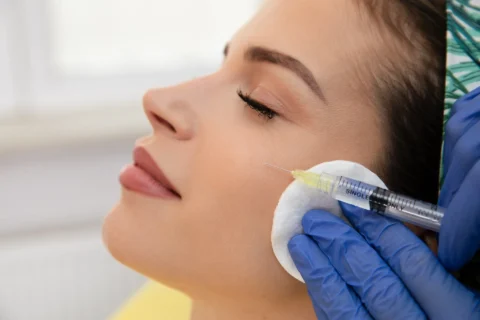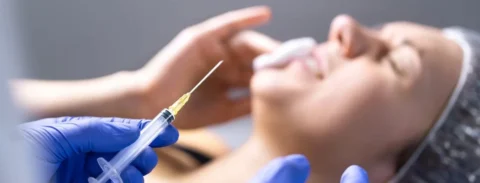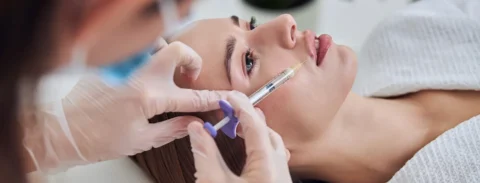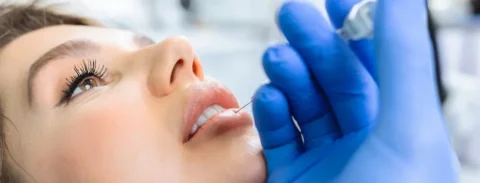For information only. Not meant as advice in any form. Please consult your medical professional or lawyer.
Dermal filler treatment is a popular cosmetic procedure for facial enhancements and anti-aging solutions. It’s a safer option because it’s non-surgical and FDA-approved. However, it’s not without risks and complications, like the development of nodules. Because of this, patients tend to ask if clarithromycin may be a reliable treatment for these abnormal tissues.
So can clarithromycin treat nodules from dermal filler injections? Yes, clarithromycin is one of the oral antibiotics prescribed for treating delayed-onset inflammatory nodules. It’s given to patients experiencing a dermal filler complication, with symptoms like tenderness, warmth, edema, or induration. This complication is caused by the body’s reaction to the facial filler or an infection. Treatment with antibiotic therapy will go for 2 weeks — in some cases, 4 weeks.
Can I Take Clarithromycin for Filler Nodule Treatment?
Oral antibiotic medication is one of the treatment options for resolving chronic delayed-onset inflammatory nodules from facial filler complications. According to a study, antibiotics like clarithromycin are given to patients as an initial treatment plan.
Dermal filler treatment is a cosmetic option for adding volume to the skin for facial enhancements and anti-aging solutions without having to deal with lengthy downtimes and hefty costs from plastic surgery.
Patients also prefer injectable fillers because they come with minimal risks and are even healthy for the skin by boosting collagen production. Most brands of HA filler hyaluronic acid dermal fillers are also FDA-approved, like Restylane Silk and Juvederm Voluma, leaving behind trails of satisfied patients.
While confidence in having dermal filler treatment is high, it’s not without side effects and risks of complications — one of them is the possibility of developing nodules or in broader terms, lumps. Antibiotics are given to patients experiencing inflamed nodules that have appeared as a reaction to dermal fillers.
But note that not all lumps from injectable fillers should be prescribed with clarithromycin or any other antibiotics, as it isn’t uncommon to develop nodules when having dermal filler injections. That’s why healthcare providers must be keen to determine if the mass is a post-procedural response or a complication needing extensive treatment.
Experiencing inflammation and spotting nodules post-treatment are some of the normal adverse events to expect — the body reacts to the substance before resorption. These lumps appearing right after your facial filler procedure typically resolve on their own after a week or two, even without antibiotic therapy. The types of nodules needing antibiotics are those that come with these symptoms:
- Abscess
- Tenderness
- Warmth
- Edema or facial swelling
- Induration
Nodules treated with oral antibiotics are inflamed lumps that have shown after a period of recovery. They appear 3 to 4 days to several months (and even years in some cases) after post-procedural adverse events have resolved. Delayed-onset inflammatory nodules are typically caused by:
- Fillers’ failure to be absorbed by the cells (development of foreign-body granulomas)
- Delayed hypersensitivity of the immune system
- Infection from:
- Bacterial biofilm
- Fungi
- Virus
- Combination of microbes (polymicrobial infection)
Like many regulations for antibiotics, patients can’t take clarithromycin for filler nodule treatment without the prescription of their physicians. Those suspecting growth from their filler injection treatment must seek immediate medical attention.
When to Take Clarithromycin for Filler Nodules
Healthcare providers won’t put a patient on antibiotic therapy because of nodules right away. They will first do extensive examinations and history-taking to gain conclusive results, accurately diagnosing the lump as inflammation from dermal filler injections. Once confirmed, the patient will be prescribed oral antibiotic medications for 2 or 4 weeks as a first-line treatment.
According to Dr. Tim Pearce in his podcast, Aesthetics Mastery Show, healthcare providers must be exhaustive in diagnosing nodules and avoid having tunnel vision during the treatment procedure during examinations.
A dermal filler complication is rare, especially with hyaluronic acid filler. Physicians must also explore other differentials before arriving at this conclusion and proceeding to treatment, even with only oral antibiotic medications. This is because many other medical conditions may also cause nodules.
Treatment with antibiotics for filler complications must start once histologic, physical, and laboratory examinations have confirmed the lumps to be delayed-onset inflammatory nodules from the injectable fillers.
How to Take Clarithromycin for Filler Nodule
Clarithromycin must be taken as a first-line treatment for delayed-onset inflammatory nodules, as prescribed by your physician for 2 weeks. A study has observed treatment of quinolones and macrolides (the class of antibiotics clarithromycin falls under) in a patient with a suspected biofilm-induced infection, given for a minimum of 4 weeks.
The types of nodules treated with clarithromycin come with facial swelling, tenderness, warmth, and induration. Doxycycline and ciprofloxacin are other types of antibiotics physicians may prescribe for delayed-onset inflammatory nodules.
How Nodules from Dermal Fillers are Treated
Before treating nodules from hyaluronic acid filler or any other dermal filler injection, physicians first determine what type of lumps they are: post-procedural or delayed-onset and inflammatory and noninflammatory.
Lumps and inflammation right after treatment with hyaluronic acid dermal fillers or any other facial fillers are normal adverse events as your body reacts to the solutions. These symptoms usually resolve on their own in a week or two. You may apply a cool compress or take paracetamol to ease discomfort.
But for a dermal filler complication involving a delayed-onset of nodules, patients can expect a more specific treatment plan. Treatment options include oral antibiotics, oral steroids, hyaluronidase, and corticosteroid injections. Other solutions are triamcinolone and fluorouracil, mechanical distribution, and excision.
1. Oral Antibiotics
As established, clarithromycin is one of the medications prescribed for inflamed delayed-onset nodules as the first line of treatment. Other broad-spectrum oral antibiotics used for treatment are ciprofloxacin and doxycycline. Once a patient responds positively to this treatment, they’ll be advised to continue medication for 2 weeks. Some physicians prescribe up to 4 weeks, depending on the infection.
2. Oral Steroids
Physicians also prescribe oral steroids for patients experiencing edema, facial swelling, or induration, alongside the appearance of nodules. But if there’s also an infection, patients receive this medication only after antibiotic therapy. A treatment option involving steroids allows the lumps to surface for intralesional therapy. Steroids are also effective for nodules that fluctuate in size.
3. Hyaluronidase
Experts also perform intralesional administrations of hyaluronidase during antibiotic and steroid treatment to remove the hyaluronic acid filler causing the lumps. This should be done immediately in areas with inflamed nodules.
Physicians usually administer this every day or two until there are no reports of improvement. This enzyme must come into contact with the HA filler to dissolve it, so patients may expect their physicians to massage the affected area for a more effective treatment.
4. Corticosteroid Injections
Physicians may also conduct intralesional injections of corticosteroids at an interval of 2 weeks if there’s still a slight appearance of lumps. This solution must be injected carefully into the nodule to keep the skin and soft tissues surrounding the treatment area from deteriorating once the nodule has resolved.
5. Combining Triamcinolone and Fluorouracil
Healthcare experts will also inject a combination of triamcinolone and fluorouracil with lidocaine as a treatment for fibrotic lesions, decreasing collagen production and reducing fibrosis. This also serves as anti-inflammatory and antibacterial medication, helping the patient to reduce their intake of steroids and lessen the risks of adverse events. These side effects from steroids include telangiectasia or spider veins and tissue atrophy.
Physicians also include clindamycin for lumps with biofilms, administered at an interval of 2 weeks. Triamcinolone injections will be discontinued once the lump has received adequate amounts of the drug, but fluorouracil and lidocaine will still be injected.
6. Mechanical Distribution
Mechanical distribution of HA filler or any other dermal filler is prescribed for noninflammatory nodules. Unlike inflammatory lumps, these nodules are firm, subtle, and cool with a regular texture caused by filler migration, poor injection technique, administering too much solution, a chronic reaction of the body’s immune-inflammatory system, or low-grade bacterial infection.
Physicians will also perform a minor dermatologic surgery involving subcisions using a sharp needle. Massaging is also an option to disperse the fillers of noninflammatory nodules, but this option is also suitable for easing side effects from post-procedural treatments. Patients may proceed with the treatment plan for delayed-onset inflammatory nodules if the mechanical distribution is unsuccessful.
7. Excision
Intralesional injections of hyaluronidase won’t resolve all complications from hyaluronic acid dermal fillers. Dermatologic surgery is also an option for lumps that won’t subside with other means. This option is also usually done for treating complications from a permanent filler.
Causes Why Dermal Fillers Develop Nodules
As established, the appearance of lumps is a normal reaction of the body as dermal fillers integrate into your skin. Post-procedural nodules and inflammation will resolve on their own in a week or two.
But when you notice a lump after the side effects from your soft tissue filler or HA injection have already healed, you might want to observe it. Seek immediate medical attention if it’s not getting any better — it might be a delayed-onset nodule. According to a study, redistribution, delayed hypersensitivity reactions, infection, and granuloma might cause it.
1. Redistribution of Dermal Fillers
HA and soft tissue filler injection may redistribute or clump, resulting in the development of nodules. This might be caused by receiving too much filler, filler migrations, poor injection techniques, too many facial movements, and other instances that may disrupt the form of the filler. Nodules caused by redistribution of dermal fillers aren’t inflammatory.
2. Delayed Hypersensitivity Reactions
Delayed-onset nodules may also be caused by the immune system’s hypersensitive response to the dermal fillers. There might be many other reasons for this event — it might be from the bacterial contamination present in the facial fillers during injection, the state of the patient’s immune system at the time of filler absorption, or the solution’s physiochemical properties during degradation.
These immunostimulatory responses are also linked to the impurities of the proteins, endotoxins, and DNA fragments of hyaluronic acid fillers. Local trauma, infections, dental cleanings, and other external factors are potential triggers for these inflammatory nodules. A study has also mentioned the industry’s interest in COVID-19 vaccines possibly triggering this reaction due to the hypersensitivity of the immune system.
3. Infection
An infection from fungi, bacteria, virus, or combination of microbes (polymicrobial infection) might also trigger the development of delayed-onset inflammatory nodules. Some dermal fillers, be it a soft tissue filler or an HA filler, might be contaminated with bacteria and grow biofilms, usually happening during the first dermal filler injection.
Biofilms are made of bacterial communities, packed densely and attached to inert surfaces or living structures. Inflammatory nodules caused by bacterial infections can be difficult to treat because secreted polymers surround the biofilms.
4. Foreign-Body Granuloma
According to a study, foreign-body granulomas are the body’s inflammatory reaction from a foreign substance (like dermal fillers) that macrophages have failed to break down. These nodules form due to a hypersensitive cell and humoral-mediated immune system reaction to the exogenous solution.
These masses form as the body attempts to trap and isolate the foreign solution from its entire system since it cannot be broken down immediately by phagocytosis or enzymatic breakdown. Foreign-body granulomas are marked by the presence of macrophages.
5. Underlying Medical Condition
An underlying medical condition involving an immune system’s hyperstimulation to adjuvants, like Autoimmune Syndrome Induced by Adjuvants (ASIA), may also be a cause of the appearance of inflammatory nodules. This is a syndrome for immune-mediated disorders.
Browse Our Catalog at FACE Med Store for Beauty and Medical Supplies for Dermal Fillers
Clarithromycin is one of the antibiotics used as a first-line treatment for delayed-onset inflammatory nodules or dermal filler complications. These lumps shouldn’t be confused with post-procedural growths, which are normal reactions to the serum and should resolve on their own in a week or two. Antibiotic therapy is only prescribed for 2 weeks or more, depending on the condition of the infection.
The presence of bacteria during dermal filler injections is one of the causes of inflammatory nodules, so investing in high-quality materials is crucial for avoiding complications from this treatment. FACE Med Store is one of the best suppliers of medical and cosmetic supplies, trusted by many practices in the country. You may browse our catalog for world-class quality supplies for dermal filler injections at competitive prices.






